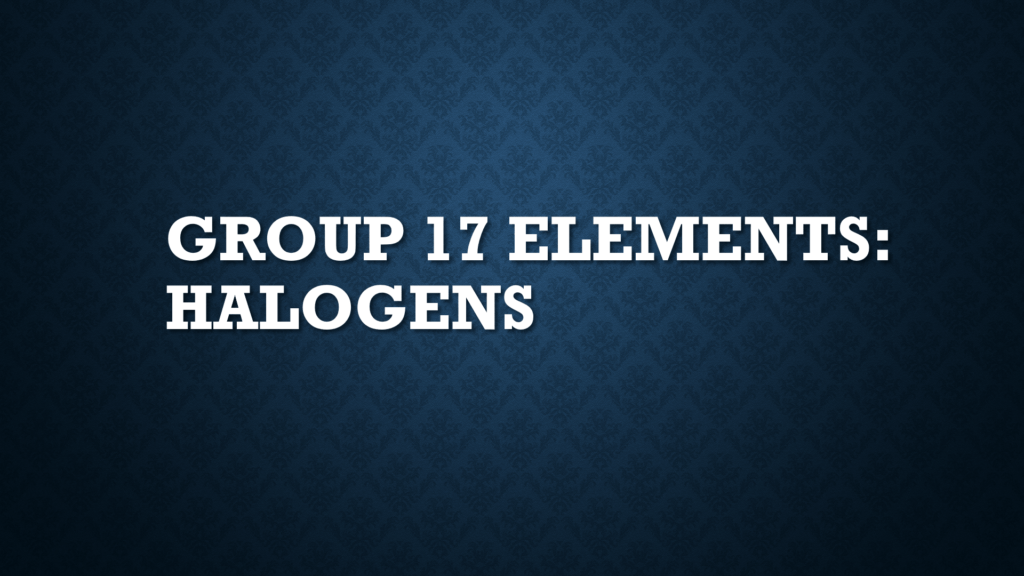The Group 17 Elements include Fluorine, Chlorine, Bromine Iodine, Astatine and Tennessine. These elements are also called Halogens, as they produce salts, when they react with metals.

Index
History
The Fluorine mineral fluorspar was known since 1529. In 1860, an English chemist, George Gore ran a current of electricity through hydrofluoric acid and produced fluorine but he was unable to prove this result.
In 1886, Henri Moissan, a chemist in Paris performed electrolysis on potassium bifluoride dissolved in hydrogen fluoride and successfully isolated fluorine.
Chlorine was known in the compound hydrochloric acid to alchemists. In 1774, Carl Wilhelm Scheele heated hydrochloric acid with manganese dioxide. The element was called dephlogisticated muriatic acid. In 1807, Humphry Davy, investigated the chlorine and discovered that is an actual element.
Bromine was discovered in the 1820s by Antoine Jerome Balard. It was discovered by passing chlorine gas through a sample of brine.
Iodine was discovered by Bernard Courtois, who was using seaweed ash for his process for saltpeter manufacture. However in 1811, when Courtois added sulfuric acid to his process, purple fumes rose which condensed into black crystals. Courtois sent this sample to other chemists for investigation. It was proven to be iodine by Joseph Gay-Lussac.
Astatine was discovered in 1940 by Dale R. Corson, K.R. Mackenzie and Emilio G. Segre, who bombarded bismuth with alpha particles.
In 2010, a team led by nuclear physicist Yuri Oganessian involving scientists from the JINR, Oak Ridge National Laboratory, Lawrence Livermore National Laboratory, and Vanderbilt University successfully bombarded berkelium-249 atoms with calcium-48 atoms to make Tennessine-294.
Group 17 Elements or Halogens
The group of halogens is the only periodic table group that contains elements in 3 main states of matter at standard temperature and pressure. The elements of this group greatly resemble properties with each other.
| Property | Fluorine | Chlorine | Bromine | Iodine | Astatine | Tennessine |
| Atomic Symbol | F | Cl | Br | I | At | Ts |
| Atomic Number | 9 | 17 | 35 | 53 | 85 | 117 |
| Atomic Mass (amu) | 18.99 | 35.45 | 79.9 | 126.904 | 210 | 294 |
| Valence Electronic Configuration | 1s22s22p5 | [Ne] 3s23p5 | [Ar] 3d104s24p5 | [Kr] 4d105s25p5 | [Xe] 4f145d106s26p5 | [Rn] 5f14 6d10 7s2 7p5 |
| Atomic Radii (pm) | 42 | 79 | 94 | 115 | 127 | 138 |
| Melting Point/Boiling Point (OC) | -219.62/-188.12 | -101.5/-34.04 | -7.3/58.8 | 113.7/184.3 | 302/337 | 350/610 |
| Density (g cm-3) | 0.0017 | 0.0032 | 3.1028 | 4.933 | 6.2 | 7.1 |
| First Ionization Energy/kJ mol-1 | 1681 | 1251.2 | 1139.9 | 1008.4 | 887.7 | 743 |
| Common Oxidation State(s) | -1 | -1, +1, +3, +75, + | -1, +1, +3, +5, +5 | -1, +1, +5, +7 | -1, +1, +3, +5, +7 | -1, +1, +3, +5 |
| Electronegativity | 3.98 | 3.16 | 2.96 | 2.66 | 2.2 | – |
Trends in Group 17 Elements
- Electronic Configuration
- Members of the halogen family have 7 electrons in their outermost orbit. The general configuration for halogens is ns2np5.
- Atomic Radii
- Atomic radii increase down the group due to increase in the number of quantum shells, Halogens have the smallest atomic radii in their respective periods, due to increase in effective nuclear charge.
- Ionisation Enthalpy
- Ionisation enthalpies for halogens are high as they have little or no tendency to lose an electron in the valence shell. The ionisation enthalpy value decreases down the group due to increase in atomic size.
- Electronegativity
- The halogens have a very high electronegativity value. Electronegativity decreases down the group due to increase in effective nuclear charge.
- Melting and Boiling Points
- The melting and boiling points increase while progressing down the group because of the van der Waals forces.
- Reactivity of Elements
- The reactivity of elements decreases down the group due to the fact that atomic radius increases in size which lessens the attraction for valence electrons of other atoms.
Applications
- Both chlorine and bromine are used as disinfectants for drinking water, swimming pools, fresh wounds, spas, surfaces and dishes.
- Chlorine is also used to create sodium chloride, table salt.
- Iodine and bromine are used in small amounts in halogen lamps.
- Halogens are also used as drug components.
- Iodine is used in printer inks, dyes, LCD displays, etc.
FAQs
This is because fluorine has seven valence electrons, it only needs one more electron to achieve a noble gas configuration. Hence it will be more likely to pull off an electron from a nearby atom.
At room temperature,
Iodine and Astatine are in Solid state,
Bromine is in Liquid state and,
Fluorine and Chlorine are in Gaseous state.
Group 17 elements are called halogens due to their ability to form salts with metals. The word halogen comes from the Greek roots hal- meaning “salt” and -gen meaning “to produce.
More on P Block
